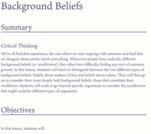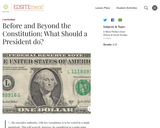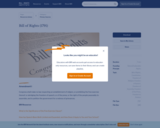
Use this lesson after reading The Constitutional Convention Narrative and/or the Constitutional Convention Lesson.
- Subject:
- Social Science
- Social Studies
- Material Type:
- Lesson Plan
- Provider:
- Bill of Rights Institute
- Date Added:
- 09/12/2022

Use this lesson after reading The Constitutional Convention Narrative and/or the Constitutional Convention Lesson.

Arizona v. Hicks (1987) clarified the need for probable cause when seizing evidence in plain view. The United States Supreme Court found that officers must reasonably suspect criminal activity in order for them to lawfully seize items in plain view without a search warrant.

This resource from the National Constitution Center includes an introduction, big questions, recorded class sessions, briefing documents, slide decks, and worksheets about Article I of the United States Constitutuion.

This resource from the National Constitution Center includes an introduction, big questions, recorded class sessions, briefing documents, slide decks, and worksheets about Article II of the United States Constitutuion.

This resource from the National Constitution Center includes an introduction, big questions, recorded class sessions, briefing documents, slide decks, and worksheets about Article III of the United States Constitutuion.

This resource from the National Constitution Center includes an introduction, big questions, recorded class sessions, briefing documents, slide decks, and worksheets about Article V of the United States Constitutuion.

This resource from the National Constitution Center includes an introduction, big questions, recorded class sessions, briefing documents, slide decks, and worksheets about Article VII of the United States Constitutuion.

In 1777, the Second Continental Congress adopted the Articles of Confederation. The objectives of this activity are: Students will analyze the provisions of the Articles of Confederation. Students will determine why individuals such as George Washington expressed a growing concern over government’s inadequacies, and why these concerns were expressed by and heightened after events such as Shays’s Rebellion. Students will explain why there was a growing call for creating a strong central government and the rationales for the various arguments.

Articles of Confederation- A brief description of the AofC and some short videos.

This activity is designed to accompany the contextual essay “Assembling, Amplifying, and Ascending: Recent Trends Among Women in Congress, 1977–2006,” from the Women in Congress website, history.house. gov/exhibition-and-publications/wic/women-in-congress/. Students have the opportunity to learn more about the women who served in Congress from 1977 to 2006. Students are encouraged to analyze the role women Representatives and Senators played in Congress during this era, as well as the ways in which they may have changed the institution.

We've all had that experience, the one where we start arguing with someone and find that we disagree about pretty much everything. When two people have radically different background beliefs (or worldviews), they often have difficulty finding any sort of common ground. In this lesson, students will learn to distinguish between the two different types of background beliefs: beliefs about matters of fact and beliefs about values. They will then go on to consider their most deeply held background beliefs, those that constitute their worldview. Students will work to go beyond specific arguments to consider the worldviews that might underlie different types of arguments.

Baker v. Carr (1962) was a landmark case concerning re-apportionment and redistricting. The United States Supreme Court ruled that federal courts could hear and rule on cases in which plaintiffs allege that re-apportionment plans violate the Equal Protection Clause of the Fourteenth Amendment.

Learn about the checks and balances system of the three branches of the U.S. government.

In this curriculum unit, students look at the role of President as defined in the Constitution and consider the precedent-setting accomplishments of George Washington.

This activity is designed to familiarize students with the legislative process. It is also intended to introduce students to legislation currently in the U.S. House of Representatives.

The Constitution might never have been ratified if the framers hadn't promised to add a Bill of Rights. The first ten amendments to the Constitution gave citizens more confidence in the new government and contain many of today's Americans' most valued freedoms.

The first 10 amendments to the Constitution make up the Bill of Rights. James Madison wrote the amendments, which list specific prohibitions on governmental power, in response to calls from several states for greater constitutional protection for individual liberties. For example, the Founders saw the ability to speak and worship freely as a natural right protected by the First Amendment. Congress is prohibited from making laws establishing religion or abridging freedom of speech. The Fourth Amendment safeguards citizensâ" right to be free from unreasonable government intrusion in their homes through the requirement of a warrant.

This lesson builds upon prior knowledge of the United States Constitution and the Bill of Rights by asking students to think critically about the issues and philosophies central to both. Through investigation and debate, students are asked to question why certain rights were added to the Constitution and why others were not. Such a discussion will encourage students to synthesize multiple historical and contemporary perspectives about their rights to decide if, in today’s world, we need different rights, if our rights are complete the way they are, or if the existing ones need change.

The first ten amendments to the United States Constitution, adopted through ratification, are collectively referred to as the Bill of Rights. As the first nine outline fundamental guarantees to the citizenry and the tenth reserves some governmental powers to the state governments, the Bill of Rights establishes limitations on the scope of the federal government. In this lesson, students will explore the history of the Bill of Rights and the meaning of the amendments included in the document through videos and activities.

This resource from the National Constitution Center includes an introduction, big questions, recorded class sessions, briefing documents, slide decks, and worksheets about the Bill of Rights in the United States Constitutuion.